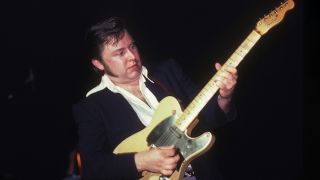Hybrid picking is a very economical method of playing guitar, as it uses fingerstyle in combination with a plectrum. This approach allows guitarists to enjoy the best of both worlds: the ability to use the plectrum to play fast lines using alternate, economy and sweep picking, but leaving the remaining picking hand fingers free to capitalize on the fluid string jumping of fingerstyle technique.
Although often associated with country and bluegrass music, hybrid picking has become popular within other genres, including jazz and fusion styles, as well as rock and blues. The main benefit of using this technique is that it saves a lot of work for the picking hand.
Rather than solely using a plectrum to navigate all of the strings all the time, hybrid picking allows the player to pick down and up strokes with their plectrum, and use their second (m) and third (a) fingers to play other strings. More advanced players may also use their fourth finger (c) as an additional picking digit. Hybrid technique allows the player to almost anchor their picking hand in a comfortable position for playing the bass notes, while using the remaining fingers to pick the higher strings.
This results in a much more economical range of motion, making arpeggios and string-skipped lines much easier to play, as different fingers can play non-adjacent strings – something that's rather tricky with only a guitar pick. Also, it allows players to pick two or more strings at the same time, as with straight fingerstyle. In situations like this, being able to play bass notes with the plectrum and partial chords with the fingers is incredibly valuable.
There is much debate over who first used the technique and brought it to prominence. But some of the top hybrid players from a country background include Albert Lee, Brent Mason, Johnny Hiland and the late, great Danny Gatton.
All of these players are considered virtuosos and brilliant examples of how to use the technique. Players from a non-country background that use hybrid include Eric Johnson, Guthrie Govan, Josh Smith, Zakk Wylde, Brett Garsed and more.
One challenge is to even out the plectrum tone with that of the fingers. Strong nails will help, but some players, such as Johnny Hiland, use acrylic add-ons so their fingers produce a similar tone to their plectrum.
Take it slowly if you are new to the hybrid style. Spending time on it will open up new and creative ways of playing the guitar, whatever genres you like to play.
Get the tone
Amp Settings: Gain 3, Bass 4, Middle 5, Treble 6, Reverb 4
Since we are not focusing on one genre or player, the tone is up to you. However, there are one or two caveats: huge amounts of distortion with hybrid can induce lots of extraneous noise, and too much delay can make the notes mush into each other. So start with a clean tone with reverb, and go from there.
Examples
Example 1. Chord playing
This first example is a simple chord based arpeggio idea, but immediately shows the benefits of using this technique. It’s advisable to follow the picking-hand directions to begin with as it’s very logical and economical. Afterwards, consider if there are any moments that are worth altering to your preferences.
Example 2. Double-stops
Here’s a series of diatonic double-stops in the key of A Major with an open A pedal tone. I used slight palm muting on the fifth string so that the note doesn’t pop or ring out too much and overly impact on the melodic line. Clarity and overall precision are very important as you get to grips with hybrid playing.
Example 3. Playing 6ths
This idea shows how hybrid picking is great when playing on non-adjacent strings. Rather than having to jump between strings with a plectrum, which can be extremely tricky, pick and finger makes it so much easier to do. It also means you can pick more than one string with no time lag between one the other.
Example 4. Banjo rolls and country licks
This example is more challenging than the previous three and is a more typical country affair, borrowed from banjo players. The ‘banjo rolls’ as they are known in the first bar may be tricky at first, so start slowly. The lick in the second bar uses mainly the plectrum, with an additional ‘m’ pluck to save too much jumping around.
Example 5. Arpeggio-based licks
This example uses Major 6th arpeggios which navigate the chords of A, D and E. This is a typical idea found in country music which, as well as using hybrid picking, shows how country guitarists often play over the changes like a jazz musician. Notice how the pick, middle and third fingers sit well over the top three strings.
Example 6. Study piece
[Bars 1-8] We open our piece with a two-bar repeated line featuring double-stops over an A pedal note. I have slightly palm muted the open fifth string so that the picked note isn’t too prominent. Aim for even dynamics between the plectrum and fingers.
At [bar 9] we introduce a new idea: a four-bar figure that’s repeated once. This idea combines more double-stops along with some sliding 6ths. Follow the suggested picking-hand fingering at first, but experiment with your own ideas once you’re comfortable. Maintain even dynamics throughout.
From [bars 17-24] onwards, we see typical banjo roll ideas used in combination with more 6ths-based ideas and a country inspired lead lick. This is probably the most challenging section of the piece, so start slowly and build up the speed.
These banjo ideas really do require hybrid picking or fingerstyle, as using a plectrum would prove difficult, if not impossible. We book-end the piece with another double-stop idea, while the final bar features a short lick which contains the only plectrum upstroke in the whole piece.

